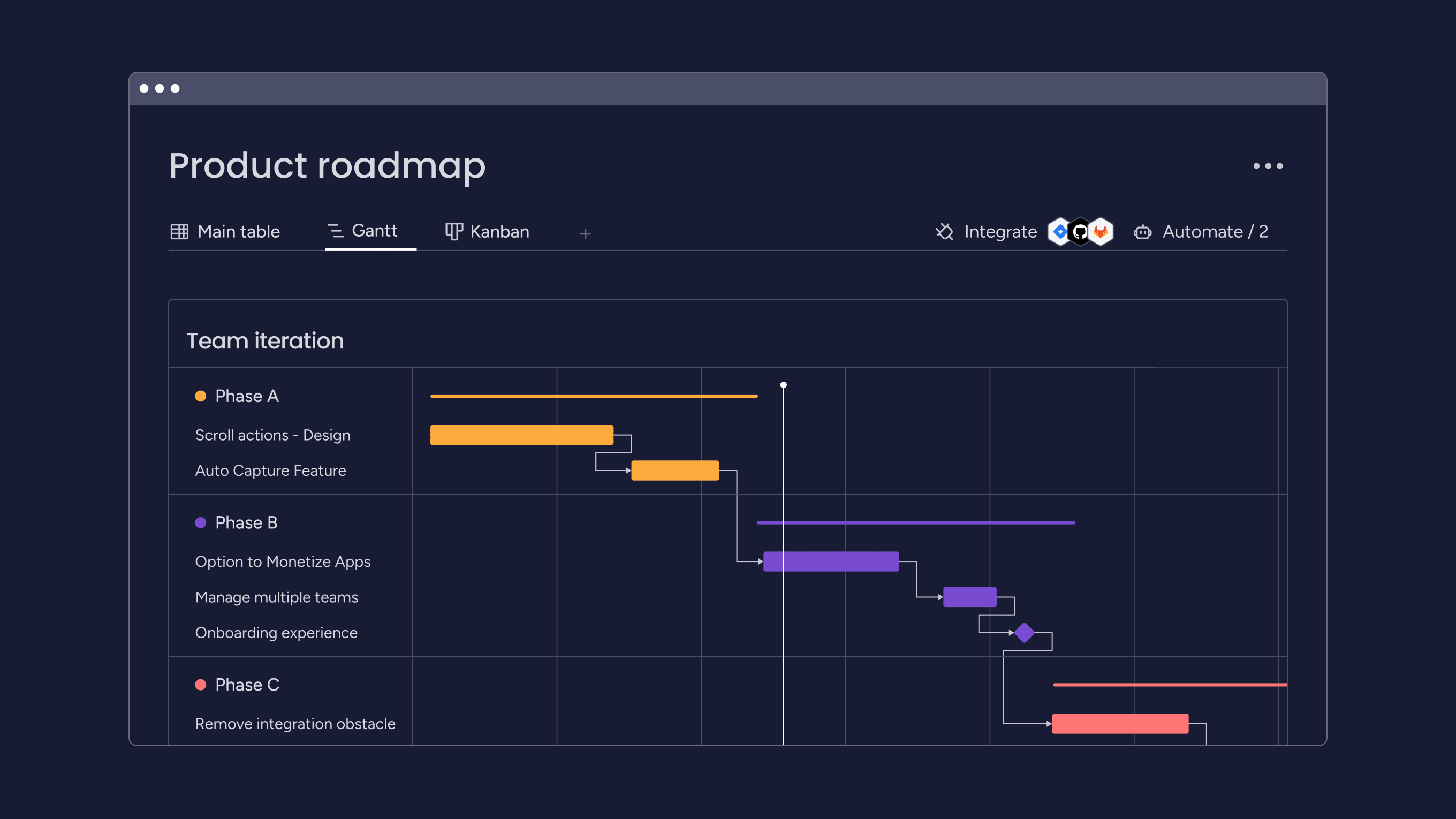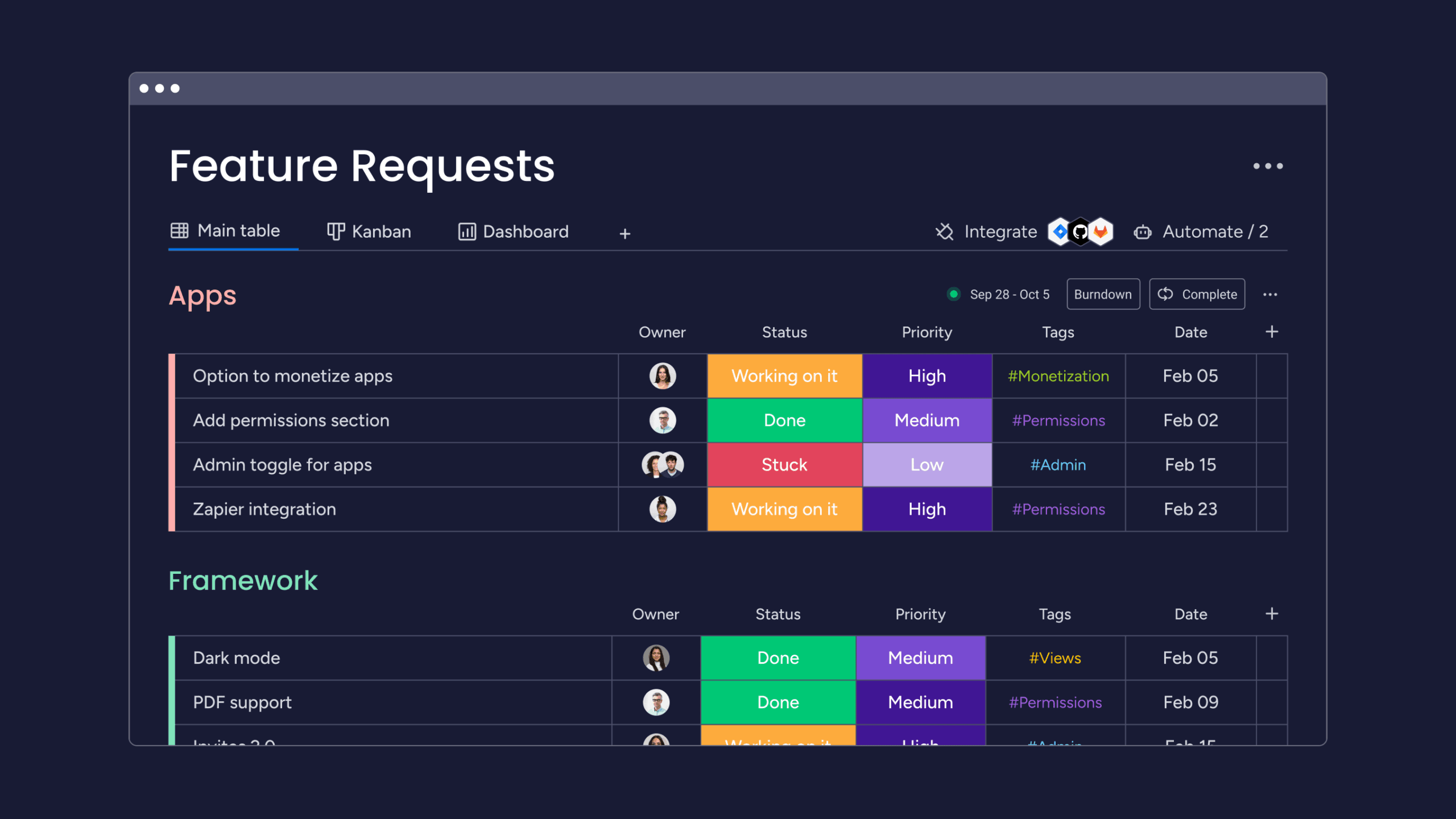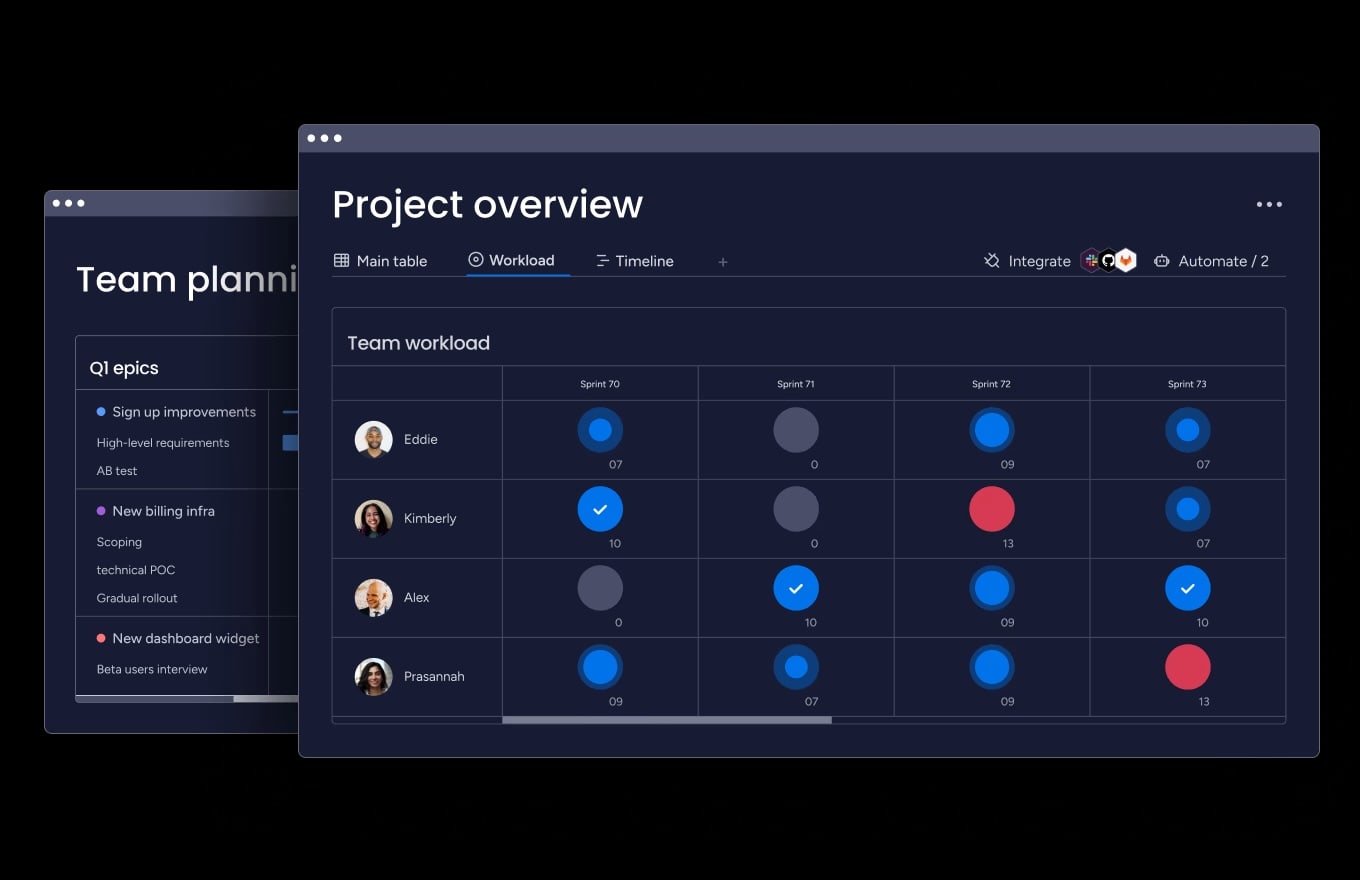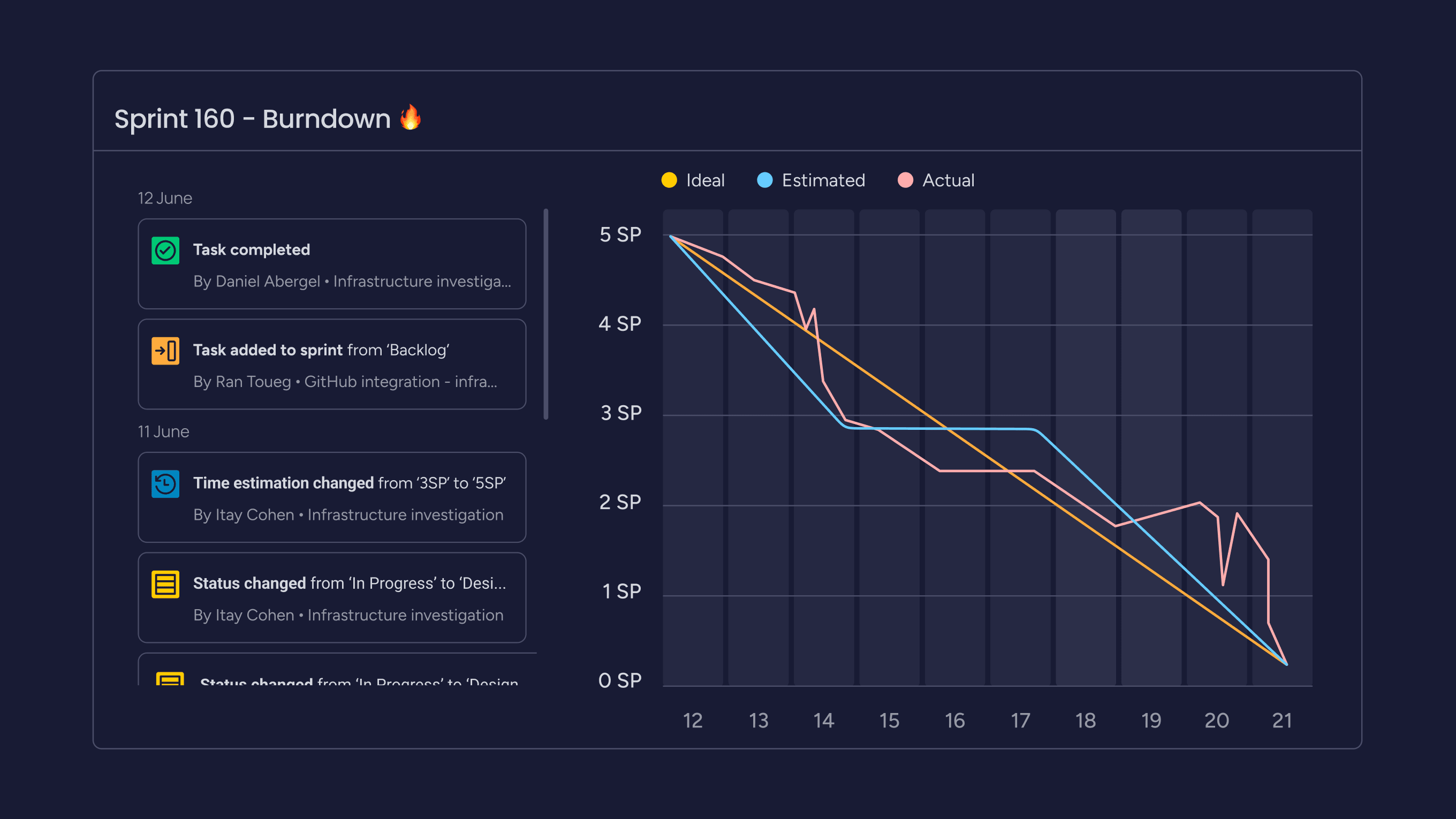Great products don’t happen by accident. They are the result of deliberate choices that connect customer needs with business goals, turning ambitious ideas into tangible value. Without a clear system, teams risk wasting resources on features that miss the mark, leading to slow delivery and disconnected efforts.
Effective product planning provides the framework for making these choices: it’s the strategic process of identifying which problems to solve, prioritizing features, and allocating resources to deliver the most impact. When done right, it aligns engineering, business, and leadership teams around a shared vision for success.
This guide breaks down the entire product planning process, from developing concepts to measuring success. We will explore the five essential steps for creating a clear plan, the key benefits of this approach, and best practices for modern development teams.
Let’s get you started on how to build a roadmap that accelerates delivery and keeps everyone focused on the right priorities!
Key takeaways
- Product planning connects strategy and execution: it ensures teams build what customers want while making the best use of resources.
- Five essential steps shape the process: define vision, analyze opportunities, build roadmaps, allocate resources, and set clear success metrics.
- Platforms like monday dev enhance planning: flexible workflows and real-time visibility link strategic goals with day-to-day execution.
- Cross-functional collaboration is critical: engineering, product, and business teams align to balance feasibility, customer needs, and market opportunities.
- Continuous planning drives success: review cycles weekly for priorities, monthly for roadmaps, and quarterly for long-term strategy.

What is product planning?
Product planning is the strategic process of identifying, developing, and managing products throughout their lifecycle, aligning with product lifecycle management frameworks. It involves deciding what to build, when to build it, and how to allocate resources to meet customer needs and business goals.
It helps to imagine product planning as your roadmap for turning ideas into reality. You’re not just listing features — you’re making strategic decisions about which problems to solve, how to deliver value to customers, and why a product plan is essential for guiding these efforts.
The building blocks of product planning
Product planning bridges the gap between business strategy and actual product development. While your business strategy sets the vision, product planning translates that vision into actionable steps and timelines.
This process requires you to understand customer needs, analyze market opportunities, and make tough decisions about priorities. You’ll need to balance what customers want with what’s technically feasible and financially viable to ensure successful product development outcomes.
Product planning vs product strategy
A product strategy defines your long-term vision and market positioning. Product planning on the other hand takes that strategy and breaks it down into specific features, timelines, and resource allocations.
While they are related in some senses, strategy and planning serve distinct functions in the product lifecycle. Understanding this difference is hugely important to ensuring your high-level vision translates into concrete, actionable steps. Here’s a clear breakdown of how they differ:
- Product strategy: sets the “why” and “what” at a high level.
- Product planning: defines the “how” and “when” for execution.
- Product strategy: focuses on market positioning and competitive advantage.
- Product planning: focuses on feature prioritization and delivery schedules.
Product planning vs go-to-market planning
Product planning comes first. It defines what to build and how it will be developed, while go-to-market planning follows by outlining how the product will be sold, marketed, and distributed.
Where product planning centres on development decisions, go-to-market planning ensures the right customers discover and adopt the product. A product launch strategy template can help bridge these two phases, creating a seamless handoff from building to launching.
The product planning process
Product planning isn’t a one-time event — it’s an ongoing cycle that adapts as you learn more about your customers and market. Each phase builds on the previous one, creating a continuous feedback loop.
The process starts with understanding your market and ends with measuring success. But really, it never truly ends because you’re always learning and adjusting.
Developing product concepts
Every great product starts with an idea, but not every idea becomes a great product. This phase helps you separate promising concepts from wishful thinking.
Kick off product discovery by gathering ideas from multiple sources — customer feedback, market research, competitive analysis, and internal brainstorming. Then evaluate each concept against your strategic goals and market opportunity.
Product management software like monday dev helps teams capture and evaluate product concepts in one place: create custom workflows to score ideas, track feedback, and move the most promising concepts forward.
Conducting market research
Market research tells you whether your product concept has real potential. You need both quantitative data (market size, growth rates) and qualitative insights (customer pain points, preferences).
To get a complete picture, you should use a mix of primary and secondary research. Primary research involves gathering new data directly from your target audience, which provides first-hand insights into their needs. Common primary research methods include:
- Customer interviews: direct conversations to understand needs and frustrations.
- Surveys: broader data collection to validate assumptions.
- Usability testing: hands-on feedback on prototypes or concepts.
Secondary research involves analyzing existing data, competitor offerings, and industry trends to understand the market landscape.
Testing and validation
Before committing major resources, you need to validate that customers actually want what you’re planning to build. This phase saves you from expensive mistakes.
Create prototypes or minimum viable products (MVPs) to test core assumptions. Gather feedback through beta programs, pilot launches, or controlled experiments.
The goal isn’t perfection — it’s learning. Each test should answer specific questions about customer needs, pricing sensitivity, or feature preferences.
Launch and continuous improvement
Launch isn’t the finish line — it’s the starting point for ongoing optimization. Modern product planning embraces continuous improvement based on real-world usage and feedback.
Monitor key metrics, gather user feedback, and track competitive moves. Use this information to plan updates, enhancements, and future versions.

5 essential steps in product planning
Turning strategy into a clear product plan doesn’t happen all at once — it unfolds through a series of deliberate steps. By moving from vision to execution in a structured way, you can prioritize effectively, stay aligned across teams, and set your product up for long-term success.
The five steps below outline how to do it:
Step 1: Define product vision and objectives
Your product vision acts as the north star for all planning decisions. It should clearly state what problem you’re solving and for whom.
A strong vision answers three questions:
- Who: your target customer and their characteristics.
- What: the core problem or need you’re addressing.
- Why: the unique value your product provides.
Write your vision in simple, concrete terms that everyone can understand. Avoid jargon or vague aspirations — be specific about the impact you want to create.
Step 2: Analyze market opportunities
Market analysis helps you understand where your product fits in the competitive landscape. You’re looking for gaps between what customers need and what’s currently available.
Start by segmenting your market to identify the most attractive opportunities. Consider factors like market size, growth potential, and competitive intensity.
Don’t just look at direct competitors — examine alternative solutions customers use today. Sometimes the biggest opportunity comes from replacing manual processes or outdated approaches.
Step 3: Create your product roadmap
A product roadmap turns your vision into a clear timeline of deliverables. It lays out what you’ll build and when, giving teams a shared view of priorities and helping everyone coordinate their efforts.
Strong roadmaps strike the right balance between detail and flexibility. Near-term initiatives should be well-defined, while longer-term plans remain open to change as new insights emerge.
With tools like monday dev, teams can create visual product roadmaps that link high-level goals directly to specific features. This makes it easier to shift priorities as needed without losing sight of the overall strategy.
Step 4: Allocate resources effectively
Resource allocation determines whether your plans become reality. You need to match your ambitions with available budget, people, and time.
Consider these resource types:
- Human resources: developer time, design capacity, QA bandwidth.
- Financial resources: development costs, infrastructure, marketing.
- Time resources: market windows, competitive pressures, internal deadlines.
Make trade-offs explicit. If you can’t do everything, be clear about what you’re choosing and why.
Step 5: Establish success metrics
Success metrics turn vague goals into measurable outcomes. They help you track progress and make data-driven decisions about future investments, which is crucial, as monday’s World of Work report found that employees who understand how success is measured are 2x more likely to feel motivated.
Choose metrics that reflect real customer and business value:
- Customer metrics: adoption rates, satisfaction scores, retention.
- Business metrics: revenue impact, cost savings, market share.
- Operational metrics: development velocity, quality measures, time-to-market.
Set targets that stretch your team but remain achievable. Review metrics regularly and adjust your plans based on what you learn.

Key benefits of product planning
Strong product planning pays off in several ways. It helps teams build solutions customers truly want, allocate resources with intention, speed up delivery, and stay aligned across departments. The sections below highlight the core benefits you can expect when planning is done well.
Meeting customer needs effectively
When you plan products systematically, you’re more likely to build something customers actually want. Planning forces you to validate assumptions before investing heavily in development.
Customer-centric planning involves regular feedback loops throughout development. You’re not guessing what customers want — you’re learning from them continuously.
This approach reduces the risk of building features nobody uses. Instead, you focus resources on capabilities that deliver real value and drive product innovation in your market.
Optimizing resource allocation
Good planning helps you use limited resources wisely. It makes it easier to identify which initiatives deserve investment and which should wait.
Resource optimization means:
- Right people on right projects: matching skills to needs.
- Balanced workloads: preventing burnout while maintaining momentum.
- Strategic focus: saying no to low-value work.
Platforms like monday dev give leaders visibility into how resources are distributed across projects. With clear dashboards, you can spot overloaded team members, rebalance work before problems escalate, and ensure the right priorities get the right attention.
Accelerating time-to-market
Structured planning actually speeds up delivery by reducing rework and confusion. When everyone understands priorities and dependencies, work flows more smoothly.
Clear plans help teams work in parallel rather than waiting for sequential handoffs. You can identify and resolve blockers before they delay launches.
Improving cross-team alignment
Effective product planning gives engineering, product, and business teams a shared language for working toward larger goals. This kind of clarity is essential, especially since monday’s World of Work report found that only 61% of employees in large enterprises are satisfied with transparency in their organization.
Regular planning sessions bring different perspectives to the table: engineers outline technical constraints, marketers highlight customer needs, and leaders provide strategic direction.
When teams align in this way, friction decreases and decisions happen faster. The result is less time spent debating priorities and more time moving work forward.
Product planning examples and approaches
There’s no single way to plan a product. The right approach depends on your goals, market, and stage of growth. Some teams focus on serving a specific customer group, others on driving retention or accelerating growth, and larger organizations often need to coordinate across entire portfolios.
The examples below illustrate how different approaches to product planning can shape strategy and execution:
Target market-driven planning
This approach starts with a specific customer segment and builds products tailored to their needs. You deeply understand one group before expanding to others.
For example, a project management platform might initially focus exclusively on software development teams. Every feature decision gets evaluated against developer needs and workflows.
Customer retention-focused planning
Some products prioritize keeping existing customers happy over acquiring new ones. This approach makes sense when customer lifetime value is high and switching costs are significant.
Planning focuses on usage data, support tickets, and customer feedback to identify improvement opportunities. You might prioritize stability and refinements over flashy new features.
Growth-oriented planning
Growth-focused planning emphasizes features that drive adoption and expansion. You’re looking for capabilities that attract new users or encourage existing users to upgrade, and reinforce your product positioning in the market.
This might mean building viral features, improving onboarding, or adding enterprise capabilities. Every planning decision gets evaluated for its growth impact.
Enterprise portfolio planning
Large organizations often juggle multiple products that must be managed in harmony. Effective product portfolio management planning makes sure these products complement one another, share resources wisely, and align with broader business strategy.
Platforms like monday dev make this easier by providing portfolio-level views across multiple products. Teams can track dependencies, allocate resources efficiently, and keep strategic alignment visible at all times, reducing the risk of overlap or conflicting priorities.

When product planning happens
As we’ve touched on above, product planning isn’t a one-time activity — it happens at multiple stages of a product’s journey. The focus shifts depending on whether you’re defining an idea, growing an established product, or adjusting strategy at key business intervals. The examples below show how planning plays a role throughout the lifecycle.
During initial product development
Early-stage planning focuses on validating the core concept and defining the minimum viable product. You’re answering fundamental questions about market fit and technical feasibility.
This phase requires flexibility since you’re learning rapidly. Plans should be detailed enough to guide work but loose enough to accommodate pivots.
Throughout the product lifecycle
Mature products need planning too. You’re balancing new features, technical debt, and maintenance work while responding to competitive pressures.
Planning cycles might align with business quarters or development sprints. The key is maintaining regular rhythm without letting planning become bureaucratic.
At strategic planning intervals
Annual or quarterly business planning creates natural points for product planning updates. You reassess market conditions, review performance, and adjust direction as needed.
These intervals provide opportunities for bigger strategic shifts. You might enter new markets, sunset old features, or fundamentally reimagine your product.
Product planning best practices for 2025
Effective product planning goes beyond setting timelines and assigning tasks. It’s about creating habits and systems that keep teams aligned, informed, and adaptable in a fast-changing market. The practices below highlight how modern teams can plan smarter in 2025.
Build a culture of continuous planning
Planning shouldn’t be a periodic event that disrupts development. Instead, make it an ongoing conversation that happens naturally within your team rhythm.
Regular planning touchpoints might include:
- Weekly: review immediate priorities and blockers.
- Monthly: assess progress against roadmap milestones.
- Quarterly: evaluate strategic direction and major pivots.
Enable cross-functional collaboration
Great products are built when diverse perspectives come together. Research from Harvard Business Review shows that highly collaborative teams are far more likely to hit their goals, which makes it essential to involve engineering, design, marketing, and customer success in your planning process. Bringing these voices into the conversation ensures true alignment and stronger decision-making.
With shared workspaces and real-time updates, platforms like monday dev make this collaboration easier. Teams can contribute their expertise, stay aligned, and move work forward without relying on endless status meetings.
Leverage data-driven decision making
Gut feelings aren’t enough anymore. Modern product planning relies on data to validate assumptions and measure success.
Useful data sources include:
- Usage analytics: wow customers actually use your product.
- Market research: competitive moves and industry trends.
- Financial metrics: revenue impact and cost implications.
Maintain flexibility in your approach
Markets change quickly, and your planning process needs to keep pace. Build in regular checkpoints to reassess and adjust rather than sticking rigidly to outdated plans.
Flexibility doesn’t mean chaos. You need structure and discipline, but within a framework that accommodates change.

The tools powering product planning in 2025
Digital collaboration platforms
Remote and hybrid teams need digital spaces to plan together effectively. These platforms replace whiteboards and sticky notes with interactive, always-updated views.
Key capabilities include real-time editing, commenting, and version control. Everyone works from the same information, reducing miscommunication and rework.
AI-powered planning solutions
Artificial intelligence helps teams analyze data, predict outcomes, and identify patterns humans might miss, and its adoption is growing; according to a 2023 Shopify report, nearly 28% of companies now use AI for product development. AI can suggest feature priorities based on usage patterns or flag risks in your roadmap.
These platforms don’t replace human judgment — they augment it with data-driven insights. You make better decisions faster.
Integration with development workflows
Planning platforms that connect with your development platforms create seamless workflows. Changes in plans automatically update in project tracking, and development progress feeds back into planning views.
This integration reduces manual updates and keeps everyone aligned: ensuring teams spend less time on administrative work and more time building great products.
Transform your product planning with monday dev
Effective product planning requires both flexibility and visibility, and that’s where platforms like monday dev make a real difference.
Instead of locking teams into rigid templates, it adapts to the way you already work while connecting high-level strategy with everyday execution. The result is a single workspace where goals, priorities, and progress stay aligned from planning through delivery.
Flexible workflows that adapt to your process
Every team approaches planning differently, which is why monday dev gives you the freedom to design workflows that fit your needs instead of forcing you into rigid templates.
With monday dev you can:
- Customize fields to capture the information that matters most to your team.
- Automate repetitive tasks with powerful automation rules that streamline sprint transitions, status updates, and notifications.
- Choose the right view with Gantt charts, Kanban boards, and Timeline views tailored to what different stakeholders need to see.
- Support any methodology by adapting to Agile, Scrum, or hybrid approaches with customizable sprint planning templates and backlog management tools.
This flexibility helps teams stay organized, aligned, and focused on delivery—without compromising on the way they work best.
Gain real-time visibility while maintaining team momentum
Managers need visibility, but not at the cost of team productivity. monday dev provides dashboards that automatically aggregate information from detailed planning boards, with real-time burndown charts and velocity tracking.
Stakeholders can check progress without interrupting developers through our comprehensive reporting features. Automated reports and status updates keep everyone informed without manual effort from your team. Set up notifications to alert team members about critical changes or blockers.
Permission controls and role-based access ensure people see what they need without overwhelming them with irrelevant details, while our activity logs track all changes for complete transparency.
Seamless alignment between business and engineering
Bridging business goals with technical realities is one of the hardest parts of product planning. monday dev makes this easier by creating shared workspaces where both perspectives stay connected.
With monday dev you can:
- Use visual roadmaps with customizable swimlanes to help non-technical stakeholders understand development complexity.
- Connect engineering tools through two-way GitHub and Jira integrations that sync development activity directly to planning boards.
- Highlight strategic priorities with tagging systems and impact scoring that make it clear how each task supports larger business goals.
- Reduce friction during execution by ensuring both business and technical teams see the same data and pull in the same direction.
This shared understanding improves planning quality, speeds up decision-making, and keeps all teams aligned on outcomes that matter.
Frequently asked questions
What is the difference between product planning and project planning?
The difference comes down to scope and focus. Product planning is strategic and ongoing, guiding what features to build and why across the entire product lifecycle. Project planning is tactical and short-term, focusing on how to execute specific development work with detailed tasks, timelines, and resource assignments for individual releases or features.
How long does the product planning process typically take?
Initial product planning for a new product typically takes four to eight weeks, depending on market complexity and available research. However, product planning is an ongoing process with regular cycles — most teams review and update plans monthly with major strategic reviews quarterly.
Can product planning work with agile development methodologies?
Product planning complements agile development by providing strategic direction while maintaining flexibility for iterative changes. Agile teams use product planning to set long-term vision and priorities, then adapt detailed plans based on sprint outcomes and continuous customer feedback.
Who should be involved in product planning decisions?
Product planning should include product managers, development leads, designers, and representatives from sales and customer success teams. The exact mix depends on your organization, but you need both technical perspectives to assess feasibility and business perspectives to ensure market alignment.
How often should product plans be reviewed and updated?
Product plans should be reviewed monthly for tactical adjustments and quarterly for strategic changes, with flexibility for significant market events. High-velocity teams might review more frequently, while stable products might extend review cycles, but regular rhythm prevents plans from becoming stale.
What tools are essential for effective product planning?
Essential product planning platforms include collaboration platforms for team alignment, road mapping software for visualization, and analytics platforms for data-driven decisions. The right platform depends on team size and complexity, but look for solutions that integrate with your existing development and communication platforms.

